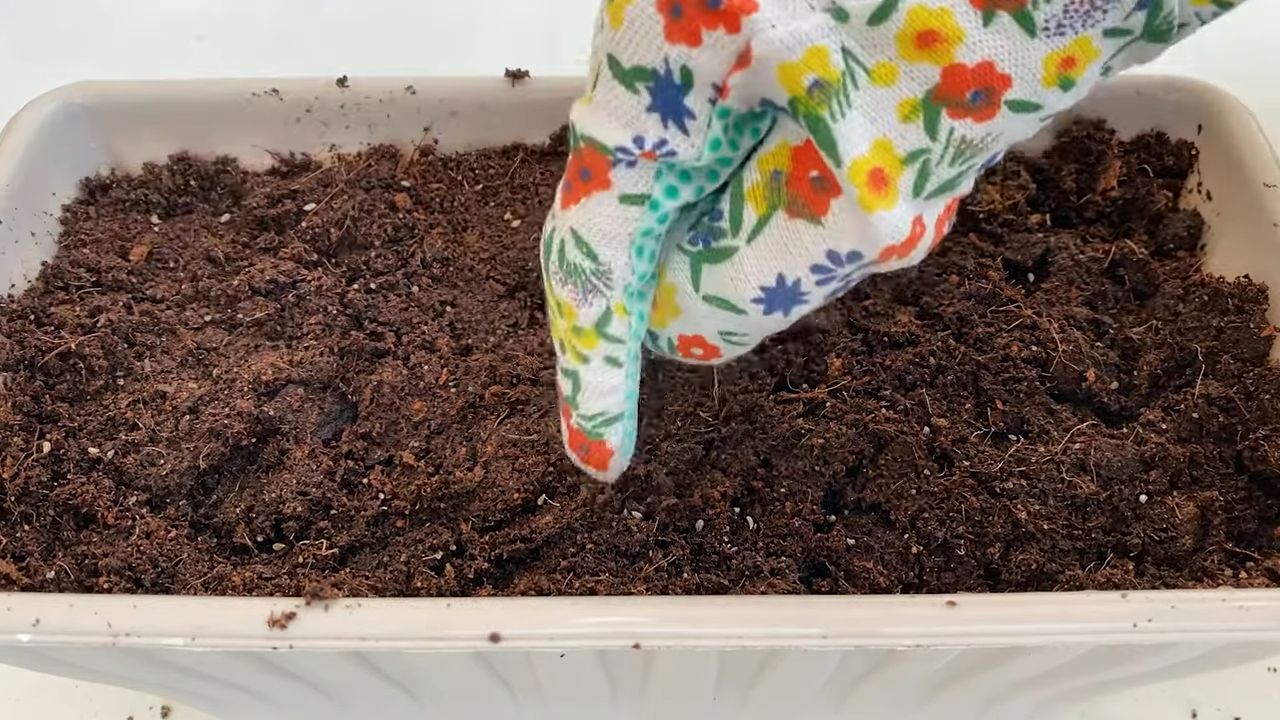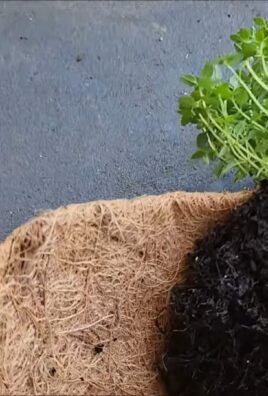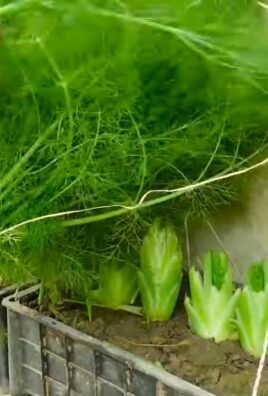Grow Parsley Kitchen Garden: Imagine stepping into your kitchen, needing a sprig of fresh parsley to elevate your dish, and simply reaching over to your own thriving little garden. Sounds idyllic, right? Well, it’s absolutely achievable, and I’m here to show you how!
Parsley, with its vibrant green leaves, isn’t just a pretty garnish. It’s been cultivated for centuries, dating back to ancient Greece and Rome, where it was used for medicinal purposes and even as a symbol of victory. Today, it’s a culinary staple worldwide, adding a burst of freshness to everything from soups and salads to sauces and stews.
But why rely on store-bought parsley that can wilt quickly and lack flavor when you can easily grow parsley kitchen garden right on your windowsill? This DIY guide will provide you with simple, effective tricks and hacks to cultivate your own flourishing parsley patch indoors. Not only will you have a constant supply of fresh herbs at your fingertips, but you’ll also save money, reduce food waste, and add a touch of greenery to your home. Plus, there’s something incredibly satisfying about nurturing your own food, even if it’s just a small pot of parsley. Let’s get started and transform your kitchen into a mini herb haven!

Your Own Parsley Kitchen Garden: It’s This Easy!
Hey garden friends! Are you tired of constantly buying expensive parsley at the supermarket, only to have it wilt in the fridge? I have the solution: your own parsley kitchen garden! It’s super easy, space-saving, and you’ll always have fresh herbs on hand. And the best part: it’s a lot of fun!
Here is a detailed guide on how you can create your own parsley kitchen garden. Don’t worry, even if you don’t have a green thumb, you can do this!
What you need:
-
Parsley seeds or a parsley plant: Seeds are cheaper, but it takes longer until you can harvest. A plant is quicker but a bit more expensive. I recommend trying both!
-
A pot or container: It should be at least 15 cm (6 inches) deep and have drainage holes. You can also use a window box or several small pots.
-
High-quality potting soil: Parsley likes nutrient-rich soil.
-
A small trowel or scoop: For filling the pot.
-
A watering can or spray bottle: For watering.
-
Optional: Starter pots, seed-starting mix, plastic wrap, or a mini-greenhouse (for starting from seed).
-
Optional: Plant labels (so you don’t forget what you’ve planted!).
-
A sunny location: Parsley loves light, but scorching midday sun can burn it. An east- or west-facing window is ideal.
Growing Parsley from Seed: Step by Step
Growing parsley from seed requires some patience, but it’s worth it! Germination can take a while, so don’t give up right away.
-
Prepare the seeds (optional, but recommended): Parsley seeds can be slow to germinate. To speed up the process, you can pre-soak them. Place the seeds in a glass of lukewarm water for 24 hours. The water should cover the seeds.
-
Prepare the starter pots: Fill the starter pots with seed-starting mix. This is particularly loose and low in nutrients, ideal for germination.
-
Sow the seeds: Lightly press down the soil and sow the seeds. Distribute them evenly on the surface. Then cover the seeds with a thin layer of soil (about 0.5 cm / 0.2 inches).
-
Water: Gently moisten the soil with a spray bottle. The soil should be damp, but not wet.
-
Create a good climate: Cover the starter pots with plastic wrap or a mini-greenhouse. This creates high humidity, which promotes germination. Place the pots in a warm, bright place (but not in direct sun).
-
Ventilate: Ventilate the pots daily by briefly removing the wrap. This prevents mold.
-
Be patient: Germination can take 2-4 weeks. Keep the soil moist, but not wet.
-
Prick out: As soon as the seedlings have 2-3 true leaves (not just the initial seed leaves), you can prick them out. This means you transplant them into larger pots. Fill the larger pots with potting soil and gently place the seedlings in. Be careful not to damage the roots.
-
Acclimatize to the location: Before you plant the young plants in their final pot or window box, you should slowly acclimate them to outdoor conditions (if you plan to keep them outside). Place them outside for a few hours a day and extend the time each day.
Sowing Parsley Directly into the Pot:
If you don’t want to use starter pots, you can also sow parsley directly into the pot where it will eventually grow.
-
Prepare the pot: Fill the pot with potting soil. Leave about 2-3 cm (1 inch) of space to the rim.
-
Sow the seeds: Distribute the seeds evenly on the surface of the soil. Cover them with a thin layer of soil (about 0.5 cm / 0.2 inches).
-
Water: Gently moisten the soil with a spray bottle.
-
Location: Place the pot in a bright, warm spot.
-
Be patient: Here too, germination can take some time. Keep the soil moist, but not wet.
-
Thin out: If the seedlings are too close together, you should thin them out. This means you remove some of the plants so the others have enough space to grow.
Planting a Parsley Plant:
If you bought a parsley plant, planting it is very simple.
-
Prepare the pot: Fill the pot with potting soil. Leave about 2-3 cm (1 inch) of space to the rim.
-
Prepare the plant: Carefully remove the parsley plant from the pot you bought it in. Loosen the roots a bit.
-
Plant: Place the plant in the prepared pot. The top of the root ball should be level with the surface of the soil.
-
Fill up: Fill the pot with soil and press it down lightly.
-
Water: Water the plant thoroughly.
-
Location: Place the pot in a bright, warm spot.
Caring for Your Parsley:
Proper care is crucial for a bountiful harvest.
-
Watering: Parsley likes it moist, but not wet. Water regularly, especially on hot days. Avoid waterlogging, as this can lead to root rot. The soil should always feel slightly damp.
-
Fertilizing: Parsley is a heavy feeder. Fertilize it every 2-3 weeks with a liquid fertilizer for herbs or vegetables.
-
Cutting: Cut the parsley regularly to encourage growth. Cut the outer leaves so the inner leaves have room to grow. Cut off the flower stalks before they open, otherwise the plant will put its energy into seed production and produce fewer leaves.
-
Location: Parsley needs a lot of light, but not scorching midday sun. An east- or west-facing window is ideal. If you keep it outside, make sure it is protected from strong winds.
-
Overwintering: Parsley is a biennial. This means it flowers in the second year and then dies. You can try to overwinter it indoors. Place it in a bright, cool spot and water it sparingly.
Common Problems and Solutions:
-
Yellow leaves: Can be a sign of overwatering, nutrient deficiency, or too little light. Check your watering habits, fertilize the plant, and move it to a brighter location.
-
Pests: Parsley can be infested by aphids or spider mites. Spray the plant with a natural insecticide or a soap solution.
-
Root rot: Is caused by waterlogging. Make sure the pot has drainage holes and don’t water too much.
Harvest:
You can harvest your parsley as soon as the leaves are large enough. Cut the outer leaves so the inner leaves have room to grow. Harvest regularly to encourage growth.
Variety:
There are different parsley varieties that differ in taste and appearance. Try different varieties to…

Conclusion
So, there you have it! Transforming your kitchen windowsill into a thriving parsley patch is not only achievable but also incredibly rewarding. We’ve walked through the simple steps, from selecting the right seeds to providing the optimal growing conditions, and hopefully, dispelled any myths about parsley’s supposed difficulty. This isn’t just about saving a few dollars at the grocery store; it’s about connecting with your food, experiencing the joy of nurturing life, and adding a vibrant, fresh element to your culinary creations.
Why is this DIY trick a must-try? Because it offers a trifecta of benefits: freshness, convenience, and sustainability. Imagine having perfectly fresh parsley, bursting with flavor, readily available whenever you need it. No more wilted bunches from the supermarket or last-minute trips when you realize you’re out. Plus, by growing your own, you’re reducing your carbon footprint and minimizing plastic waste. It’s a small change that makes a big difference.
But the beauty of this project lies in its adaptability. Feel free to experiment with different varieties of parsley. Curly parsley adds a classic touch, while flat-leaf (Italian) parsley boasts a more robust flavor. You can even try growing both in separate containers to have a wider range of culinary options. Consider companion planting too! Basil, tomatoes, and carrots are known to thrive alongside parsley, creating a mini-ecosystem right in your kitchen.
Don’t be afraid to get creative with your containers. While terracotta pots are a classic choice, you can repurpose old jars, tin cans (with drainage holes, of course!), or even create a vertical garden using recycled pallets. The possibilities are endless! Just remember to ensure adequate drainage and choose a container that’s large enough to accommodate the parsley’s root system.
We understand that gardening can sometimes feel daunting, especially for beginners. But growing parsley is surprisingly forgiving. With a little patience and attention, you’ll be amazed at how quickly your seeds sprout and transform into lush, green plants. Remember to provide ample sunlight, water regularly, and harvest frequently to encourage continued growth.
And speaking of harvesting, don’t be shy! Parsley thrives on being trimmed. Snip off the outer stems as needed, leaving the inner stems to continue growing. This will not only provide you with a constant supply of fresh herbs but also prevent the plant from becoming leggy and overgrown.
Ultimately, this DIY project is about more than just growing parsley; it’s about fostering a deeper connection with nature and embracing a more sustainable lifestyle. It’s about experiencing the satisfaction of creating something beautiful and useful with your own hands.
So, we wholeheartedly encourage you to give this DIY trick a try. Start small, be patient, and don’t be afraid to experiment. We’re confident that you’ll be delighted with the results. And most importantly, we want to hear about your experience! Share your photos, tips, and challenges in the comments below. Let’s create a community of parsley-loving gardeners and inspire others to embrace the joy of growing their own herbs. Let us know how your **grow parsley kitchen garden** is doing!
Frequently Asked Questions (FAQ)
What is the best time of year to start growing parsley indoors?
Parsley can be started indoors at any time of year, as long as you can provide adequate light. However, starting in early spring (February-March) is often recommended, as this allows the seedlings to establish themselves before the warmer months arrive. If you live in a region with harsh winters, starting indoors is a great way to get a head start on the growing season. You can then transplant the seedlings outdoors once the weather warms up and the risk of frost has passed.
How much sunlight does parsley need when grown indoors?
Parsley thrives in bright, indirect sunlight. Aim for at least 6-8 hours of sunlight per day. If you don’t have a sunny windowsill, consider using a grow light to supplement the natural light. Place the grow light a few inches above the plants and keep it on for 12-14 hours per day. Rotate the plants regularly to ensure even exposure to light. Insufficient light can lead to leggy growth and a lack of flavor.
What type of soil is best for growing parsley in containers?
Parsley prefers well-draining soil that is rich in organic matter. A good potting mix specifically formulated for herbs or vegetables is ideal. You can also create your own mix by combining equal parts of potting soil, compost, and perlite or vermiculite. The compost will provide essential nutrients, while the perlite or vermiculite will improve drainage and aeration. Avoid using garden soil, as it can be too heavy and may contain pests or diseases.
How often should I water my indoor parsley plant?
Water your parsley plant regularly, keeping the soil consistently moist but not waterlogged. Check the soil moisture by sticking your finger about an inch into the soil. If it feels dry, it’s time to water. Water deeply, until water drains out of the bottom of the pot. Avoid overwatering, as this can lead to root rot. During the warmer months, you may need to water more frequently.
How do I harvest parsley without damaging the plant?
Harvest parsley by snipping off the outer stems near the base of the plant. This will encourage new growth from the center. Avoid cutting off more than one-third of the plant at a time. Regular harvesting will also help to prevent the plant from bolting (going to seed), which can make the leaves bitter. Use sharp scissors or pruning shears to make clean cuts.
Why is my parsley plant turning yellow?
Yellowing leaves can be a sign of several problems, including overwatering, underwatering, nutrient deficiencies, or pest infestations. Check the soil moisture to ensure that you’re not overwatering or underwatering. If the soil is consistently wet, allow it to dry out slightly before watering again. If the soil is dry, water deeply. You can also try fertilizing your parsley plant with a balanced liquid fertilizer to address any nutrient deficiencies. Inspect the plant for pests, such as aphids or spider mites, and treat accordingly.
Can I grow parsley from cuttings?
While it’s more common to grow parsley from seeds, you can also propagate it from cuttings. Take a cutting from a healthy stem, about 4-6 inches long. Remove the lower leaves and place the cutting in a glass of water. Change the water every few days. Once roots have developed (usually within a few weeks), you can transplant the cutting into a pot filled with potting mix.
How do I prevent parsley from bolting?
Bolting is a natural process that occurs when parsley plants are exposed to high temperatures or long days. To prevent bolting, keep your parsley plant well-watered and provide it with some shade during the hottest part of the day. Regular harvesting can also help to delay bolting. If your parsley plant does bolt, you can still use the leaves, but they may have a slightly bitter taste.
What are some common pests that affect parsley plants?
Common pests that can affect parsley plants include aphids, spider mites, and whiteflies. These pests can suck the sap from the leaves, causing them to yellow and wilt. Inspect your parsley plant regularly for signs of pests. If you find any, you can try washing them off with a strong stream of water or using an insecticidal soap.
Can I freeze parsley for later use?
Yes, freezing parsley is a great way to preserve its flavor and freshness. Wash and dry the parsley thoroughly. You can either chop it finely or leave it in whole sprigs. Place the parsley in a freezer bag or airtight container and freeze for up to 6 months. You can also freeze parsley in ice cube trays with water or olive oil. This is a convenient way to add small amounts of parsley to soups, stews, and sauces.




Leave a Comment